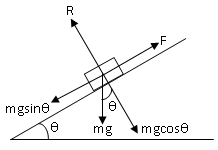Construction
Searching For SandThe antlion does is capable of moving pits, and when it is at an area that works well for trap building, the antlion will then begin the process of digging.
|
Creation of PitTo begin the digging process, the antlion moves backwards in a circle while flinging sand out and away from the soon to be center of the pit. The digging is slow and shallow, but eventually a steep pit is created, and the antlion digs into the center.
|
CompletedThe antlion has completed the trap and now waits for prey items to fall in. For a prey item to fall into the trap, the force of gravity must be stronger than the friction of the grains of sand, and force the prey to slide into the center.
|
The Physics Behind the Trap
The Avalanche AngleThe avalanche angle is another name for the angle of repose of a granular slope. The angle of repose is the minimum angle at that causes an object on a slope to just begin motion. The factors that go into determining the angle of repose of a slope are: mass of the object, normal force, friction and angle of the slope. Solving for the angle of friction gives you what the angle of repose is.
|
Size MattersResearchers at the University of Rennes have conducted research on the pits of antlions and reached the conclusion that only medium sized ants (roughly 2mg) have the highest chance of capture. That is mainly due to the fact that the ants would never get the opportunity to stop themselves from sliding because they couldn't produce the vertical force necessary to stop downward motion along with the sand cascade.
Insects larger than this were found to create footprints that stabilize the sand while insects smaller than this did not disturb the sand particles. Friction plays a major role in determining whether or not the sand will be disturbed enough to form a cascade of sand leading to the prey falling to the bottom of the pit. |
Frictions Role The traps created by antlions have an angle at or near the angle of repose for the material that they are digging into. Not all antlion types keep to the same angle, or they would not be as successful as they are known to be. The angle of the pits is just enough that the coefficient of static friction can be overcome with a fairly small level of downward force, such as a perfectly sized ant.
The larger the potential prey is, however, the greater the possibility that the object (prey) sliding down the slope creates a rim (footprint) that puts a large enough drag force to overcome the gravitational force that started it moving down the slope to begin with. They then can move out safely from the pit as they please. |





